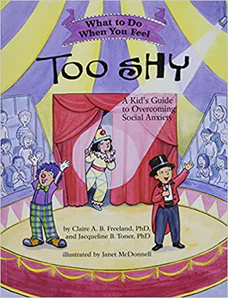What to Do When You Feel Too Shy
A Kid's Guide to Overcoming Social Anxiety
Written by A. B. Freeland, Ph.D. and Jacqueline B. Toner, Ph.D.
Illustrated by Janet McDonnell
96 pages
•
Published 2016 (Magination Press)

Recommended Age Range: Mid- to late-elementary schoolers, but much of the book is applicable to kids a bit younger with some extra parental support.
Publisher's Summary:
What to Do When You Feel Too Shy guides children and their parents through the emotions underlying social anxiety using strategies and techniques based on cognitive-behavioral principles. This interactive self-help book is the complete resource for educating, motivating, and empowering children to overcome social anxiety — so they can join in the circus of fun and friends!

Dr. Annie's Takeaways
Recommended for: This workbook is likely to be useful to children with social anxiety who would like to feel more comfortable in social situations and who don’t hate clowns (there are some prominant clown references). It’s most relevant to children who are anxious when interacting with peers, but the interventions also apply to kids with performance-type anxiety (e.g., when giving a presentation, perfoming in a recital). It’s a great introduction to cognitive behavioral therapy (CBT)
for social anxiety. This workbook could be completed over a number of weeks by caregivers and children, in a therapy office, or as “homework” between therapy sessions.
Would a child like it? A child with some insight into their social anxiety would probably like it. The workbook style of these books is engaging and adds a little fun. Social anxiety is painful to experience, and this book provides a pathway toward relief.
Tone: Instructive, motivating
Story Quality: This workbook uses a metaphor of circus performers to teach children about social anxiety and how to “tame” it. It’s an effective metaphor, although a bit dated, as traditional circuses (e.g., lion tamers, clowns) are losing popularity amid concerns about animal welfare and general changes in taste. Aside from this concern (which may be a deal breaker to some; it made me a bit uncomfortable), the writing is clear and developmentally appropriate, and it speaks directly and respectfully to the child reading the workbook. There are activities interspersed for a child to complete, such as writing their ideas for “Confident Thoughts” to challenge different anxiety thoughts. These activities aren’t super fun, but they are mostly helpful.
Illustrations: Black and white watercolor illustrations to accompany the text.
Representation: Children with different skin tones, hair, and genders are portrayed in the illustrations throughout the text. A few examples include mentions of Mom or of Dad but it is not implied that all children have a mom and a dad.
Psychological Practices: This book is a collection of the greatest hits of Cognitive-Behavioral Therapy (CBT) for social anxiety. It includes psychoeducation
about what social anxiety is and how it gets in the way (e.g., preventing a child from joining a fun activity); how it makes one’s body feel (e.g., shaky legs, red face, tightness in chest); the connection between worry thoughts, anxiety, and avoidance; different types of worry thoughts (spotlight thoughts, mind-reading thoughts, and self-doubting thoughts) and how to combat them with confident thoughts; an exposure hierarchy (i.e., practicing feared scenarios starting with the easiest ones and working up to more difficult ones); social skills including conversation and self-advocacy; relaxation strategies; and positive self-talk.
Concerns: Although some children with social anxiety have some challenges with social skills, many do not. There are two chapters on social skills (conversation skills and self-advocacy skills) which might not be relevant to all children with social anxiety. That said, the activities in these chapters could be a useful way to assess whether a child has adequate social skills but is anxious about using them, or whether they do need to learn some skills in order to be successful in social situations.
